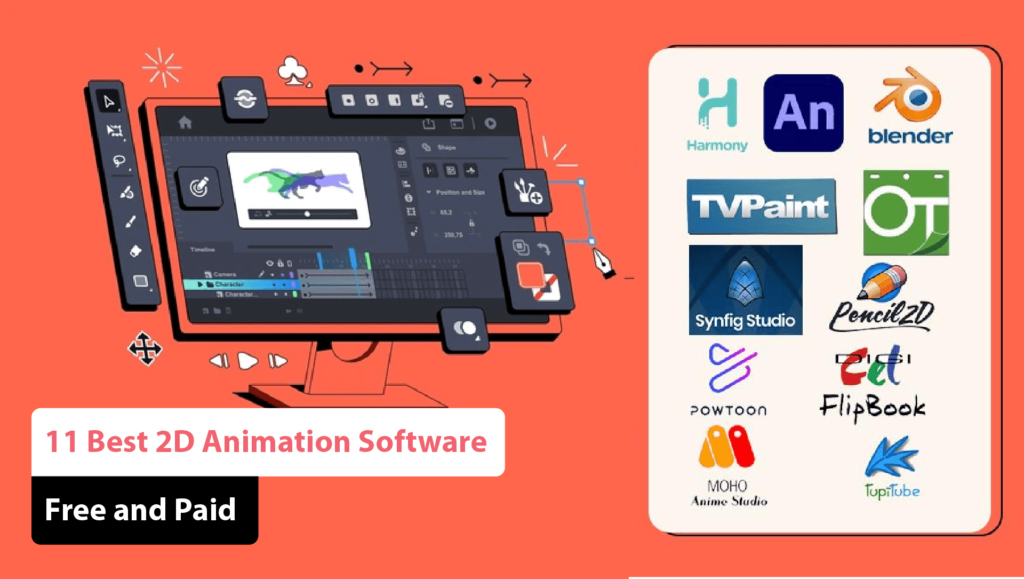
The Rise of 2D Animation: Unleashing Creativity and Innovation:
Whether you’re an aspiring YouTuber, a hobbyist learning animation, or a seasoned professional at an animation studio, having the right software makes all the difference. In 2025, the variety and quality of 2D animation tools have reached new heights, offering powerful features across free and paid platforms.
In this guide, we’ll introduce the 11 best 2D animation software 2025, comparing the top options for every skill level, from free 2D animation software for beginners to top paid 2D animation tools for professionals.
We’ll also highlight:
- Easy 2D animation software for beginners
- Platforms ideal for YouTube animation
- Cross-platform compatibility for PC & Mac
- Recommendations for the best software for animators and studios
Let’s dive into the tools that are defining modern 2D animation in 2025.
1. Toon Boom Harmony (Paid)
Toon Boom Harmony remains the industry-leading professional 2D animation software in 2025.
Best for: Animation studios, broadcast productions, and feature films.
Key Features:
- Advanced rigging and deformer tools
- Frame-by-frame and cut-out animation
- 3D camera support
- Vector and bitmap hybrid workflow
Platform: PC & Mac
If you’re running a studio or want to work in TV/film animation, Harmony is one of the best software for animators and studios.
2. OpenToonz (Free)
An open-source favorite, OpenToonz is ideal for those seeking a full-featured free 2D animation software for beginners.
Best for: Indie creators, students, and experimental animators
Key Features:
- Used by Studio Ghibli
- FX plugin support
- Customizable tools for unique workflows
Platform: PC & Mac
This is a great pick for those creating 2D animation software for YouTube videos with zero budget.
3. Moho (Anime Studio) (Paid)
Moho Pro 2025 is one of the top paid 2D animation tools that combines rig-based animation with traditional frame-by-frame capabilities.
Best for: Intermediate users, independent filmmakers, educators
Key Features:
- Smart bones and physics
- 2D rigging with advanced control
- Timeline-based editing
Platform: PC & Mac
Moho is intuitive enough for newcomers yet powerful for pros.
4. Adobe Animate (Subscription)
Formerly Flash, Adobe Animate continues to evolve in 2025 as a versatile tool for 2D animation and interactive content.
Best for: Web animators, marketing videos, interactive media
Key Features:
- Symbol-based animation
- HTML5 and SVG export
- Tight Adobe Creative Cloud integration
Platform: PC & Mac
It’s great for those creating animations for websites or apps and serves well as an easy 2D animation software for beginners with Adobe ecosystem experience.
5. Pencil2D (Free)
Simple, lightweight, and open-source, Pencil2D is ideal for hand-drawn, frame-by-frame animation.
Best for: Absolute beginners, kids, and sketch animators
Key Features:
- Minimalist interface
- Raster/vector switching
- Onion skinning
Platform: PC, Mac, Linux
It’s one of the best free 2D animation software for beginners starting from scratch.
6. Blender (Grease Pencil) (Free)
Known for 3D, Blender’s Grease Pencil feature brings powerful 2D animation tools into a 3D space.
Best for: Hybrid 2D/3D artists, experimental animators
Key Features:
- Full 2D drawing in 3D environment
- Rigging, layering, keyframing
- Perfect for motion comics or complex scenes
Platform: PC, Mac, Linux
Blender is not just a free 2D animation software for beginners, but a full studio in one open-source platform.
7. Krita (Free)
While best known as a digital painting app, Krita now offers frame-by-frame animation tools for bitmap workflows.
Best for: Illustrators, comic artists, indie animators
Key Features:
- Onion skinning and timeline
- Audio layer support
- Brush engine for expressive animation
Platform: PC, Mac, Linux
Krita is particularly strong for expressive, art-driven animation.
8. TVPaint Animation (Paid)
A bitmap-based professional 2D animation software used in high-end productions.
Best for: Feature film animators, traditional artists, fine art animation
Key Features:
- Multi-layered, paint-style animation
- Advanced timing control
- Non-destructive editing
Platform: PC & Mac
It’s often chosen by those who want a classic animation feel with modern digital efficiency.
9. Synfig Studio (Free)
Synfig Studio is a vector-based free 2D animation software for beginners who want tweened animations.
Best for: Budget-conscious animators, basic explainer videos
Key Features:
- Vector animation with keyframe interpolation
- Sound syncing
- Advanced controls for cut-out style animation
Platform: PC, Mac, Linux
Its focus on automating transitions helps streamline workflows for beginners.
10. Procreate Dreams (Paid, iPad)
From the makers of Procreate, Dreams is a new 2D animation app built for Apple devices.
Best for: Mobile creators, artists on-the-go
Key Features:
- Optimized for Apple Pencil
- Gesture-based timeline
- Real-time preview and editing
Platform: iPad (iOS only)
Dreams offers one of the most intuitive mobile experiences and is ideal for 2D animation software for YouTube videos.
11. FlipaClip (Free & Paid)
Popular among social media creators, FlipaClip is an easy entry-point for mobile animators.
Best for: Beginners, casual creators, social content
Key Features:
- Frame-by-frame drawing
- Audio support and basic timeline
- Easy sharing to TikTok or YouTube
Platform: Android & iOS
FlipaClip proves that even an easy 2D animation software for beginners can create viral content.
2D Animation Software Comparison (2025)
| Software | Type | Platform | Best For | Free Version |
|---|---|---|---|---|
| Toon Boom Harmony | Paid | PC & Mac | Studios, TV production | No |
| OpenToonz | Free | PC & Mac | Students, indie creators | Yes |
| Moho | Paid | PC & Mac | Rig-based indie projects | No |
| Adobe Animate | Subscription | PC & Mac | Web & interactive animation | Trial |
| Pencil2D | Free | All platforms | Kids, frame-by-frame learning | Yes |
| Blender | Free | All platforms | 2D/3D experimental workflows | Yes |
| Krita | Free | All platforms | Painterly animations | Yes |
| TVPaint | Paid | PC & Mac | Hand-drawn film-quality animation | No |
| Synfig Studio | Free | All platforms | Vector-based tweened animation | Yes |
| Procreate Dreams | Paid | iOS | Tablet-based content creation | No |
| FlipaClip | Freemium | iOS & Android | YouTube Shorts, TikToks | Yes |
Best Animation Software for PC & Mac in 2025
If you’re looking for the best animation software for PC & Mac, here are our top choices:
- Pro-Level: Toon Boom Harmony, Moho, TVPaint
- Beginner-Friendly: OpenToonz, Synfig, Pencil2D
- Creative Freedom: Blender (Grease Pencil), Krita
Cross-platform compatibility ensures you can work from any device, whether Windows or macOS.
Best Animation Software for YouTube Videos
Want to grow your YouTube channel with animation in 2025? Check out these:
- FlipaClip: Perfect for short-form and story-driven content
- Procreate Dreams: Great for drawing-focused animations
- OpenToonz: Ideal for narrative-driven 2D shorts
- Moho: Smooth rig-based animation for character storytelling
These tools excel in quick output and quality storytelling, ideal for YouTube.
Tips for Choosing the Right Software
Choosing among the best 2D animation software 2025 can feel overwhelming. Here’s how to narrow it down:
1. Skill Level
- Beginner: Pencil2D, FlipaClip, Synfig
- Intermediate: Moho, Krita, OpenToonz
- Pro: Toon Boom Harmony, TVPaint
2. Project Type
- YouTube: FlipaClip, OpenToonz
- Web animations: Adobe Animate
- Film & TV: Harmony, TVPaint
3. Budget
- Free tools: Blender, Pencil2D, Krita, Synfig
- Paid tools: Harmony, Moho, Dreams
4. Device Compatibility
- PC: Most platforms
- Mac: All listed except Pro-only software with Windows limitations
- iPad: Dreams, FlipaClip
Final Thoughts
In 2025, the line between free and paid 2D animation software is blurrier than ever. From powerful open-source tools like Blender and Krita to premium platforms like Toon Boom Harmony and Moho, there’s a perfect solution for every animator.
This guide to the best 2D animation software 2025 ensures you find the right tool—whether you’re looking for free 2D animation software for beginners, need tools to produce 2D animation software for YouTube videos, or you’re managing a studio with high-end needs.
Animation is more accessible than ever. Dive in, explore the options, and bring your stories to life in motion.
Frequently Asked Questions (FAQ’s)
What Is 2D Animation?
Let’s explore the question: “What is 2D animation?” This animation style focuses on creating two-dimensional characters and objects within a flat space, where each drawing has width and height but no depth. Artists use specialized 2D animation software to sequence individual images, typically displaying one drawing for every two frames in a standard 24 frames-per-second film. While classic Disney films showcase this technique, 2D animation is also widely used in commercials, corporate marketing, and video games.
The complexity of 2D animation can vary, and strong static drawing skills are essential for creating engaging cartoons. Aspiring animators must be versatile in depicting characters and objects, as studio revisions can be costly. Fortunately, advancements in technology have made 2D animation more accessible, with free software and online courses available to help beginners learn the craft.
Do you need to be a good artist to use 2D animation software?
While being a skilled artist can help with creating visually appealing animations, it’s not a strict requirement. Many 2D animation software programs come with tools like pre-made assets, rigs, and templates that make it easier to bring characters to life without advanced drawing skills. However, having a basic understanding of drawing and storytelling can enhance the quality and creativity of your animations. With time and practice, your artistic skills can improve as you work on more projects.
What kind of computer do you need for these tools?
For 2D animation, a computer with a good processor (Intel i5 or better), at least 8 GB of RAM, and a dedicated graphics card is recommended. A high-resolution display is also important for working with detailed animations. Macs and PCs are both capable of running 2D animation software, but it’s essential to ensure your computer meets the system requirements of the software you choose. Having a tablet or stylus can also boost your efficiency when creating hand-drawn elements.
What features are important for 2D animation software?
Key features to look for in 2D animation software include:
- Frame-by-frame animation tools to create smooth transitions between movements.
- Onion skinning to view multiple frames at once, making it easier to draw movements.
- Vector and raster support to give flexibility in creating detailed or scalable images.
- Bone rigging to animate characters efficiently without redrawing each frame.
- Export options to ensure you can easily publish your work in various formats. Having a user-friendly interface is also important for smooth workflow, and software updates keep your tools up to date with industry trends.
What is raster vs. vector graphics?
- Raster graphics are made up of pixels and are best suited for detailed, complex images. However, they lose quality when scaled up. Examples include photographs and intricate artwork.
- Vector graphics, on the other hand, use mathematical paths, allowing them to be scaled infinitely without losing quality. They are ideal for creating sharp, clean animations and logos. Both formats serve different purposes, so knowing when to use each can improve your animation’s clarity and visual impact.
What factors should you consider when choosing software?
- Your skill level: Beginners might prefer user-friendly tools like Toon Boom or OpenToonz, while advanced animators may lean towards Adobe Animate or TVPaint.
- Project complexity: If you’re working on complex animations with detailed characters, ensure the software offers advanced rigging and effects features.
- Budget: Some programs, like Synfig or Krita, are free, while others like Adobe Animate require a subscription.
- Support and resources: Consider software with a strong user community, tutorials, and customer support to help you learn and troubleshoot.
- Export options: Make sure the software can export in the formats you need, such as MP4, GIF, or high-resolution PNG sequences. The software’s ability to integrate with other programs and plugins can also expand your creative potential and streamline your production pipeline.





